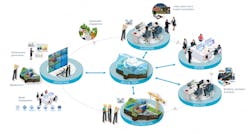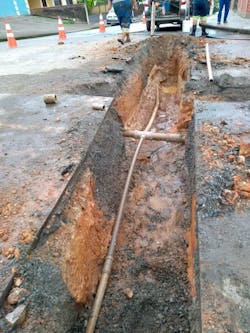Digital Twins for Managing Water Infrastructure
Rising electricity prices. Financing for capital improvements. Aging assets and infrastructure. Water scarcity and loss. Growing urban populations and shrinking rural ones. The havoc wreaked by climate change such as hurricanes, floods, and droughts.
These are some of the problems that water utilities face in their effort to provide reliable, resilient, and affordable water systems. And, the solutions are similarly wide-ranging, from public-private partnerships to conservation awareness to smart water technologies. And, increasingly, utilities are adding digitalization to this list.
Digital strategies
Good data is fundamental to good decision-making. But often, utilities struggle to effectively use the data they already have and the data they routinely collect because it is isolated in disconnected IT solutions, spreadsheets, and paper records. Digitalization of data and the business processes it supports can help utilities get the most out of their data to improve their decision-making, efficiency, and service. And, digital twins are a very powerful strategy that progressive water utilities are adopting.
A digital twin is a virtual representation of a physical asset, process, or system. The creation of a water system’s digital twin involves integrating virtual engineering models with city-scale reality models and GIS data. Additionally, digital twins are continuously updated with virtual operational data from SCADA systems, sensors, meters, and other measured sources—creating a real-time model that can be used in operations. And, that is what differentiates digital twins from static 3D models.
The end result is an intelligent and connected digital infrastructure model that supports planning, design, construction, and operations for smart water networks. Digital twins of water systems provide accurate and reliable data that utilities can use to perform what-if analyses and make informed decisions throughout the lifecycle of a water system—from long-term system vulnerability and capacity planning to immediate performance monitoring and emergency response.
Using digital twins
Digital twins allow utility workers to visualize an asset (in the context of the system and the surrounding environment), check its status, and perform analyses and simulations. This enables utilities to better understand past and current performance of their water systems while helping them predict future performance and simulate the impact of potential changes in the virtual world before funds are committed.
Digital twins give utilities actionable insights that help them predict performance and identify failures before they happen. Digital twins optimize asset performance and risk-based planning/emergency preparedness. By leveraging data more effectively and making better use of the vast amounts of data they already collect, digital twins generate insights that help utilities predict and optimize the current and future performance of their assets and water system.
Why digital twins matter
- By incorporating a hydraulic/water quality model of the system that reflects current conditions, digital twins enable utilities to simulate events such as pipe failure, power outages, fires, and contamination. As a result, the model helps utilities analyze the resilience of their systems and assess their risk.
- Digital twins can leverage data from existing work management and asset management systems, as well as other enterprise systems to support risk-based strategic lifecycle asset management. These benefits help utilities optimize lifecycle costs, extend the useful life of assets, and prioritize capital improvement projects.
- Continuously updating digital twins with measured operational data helps a utility determine the location of potential leaks as well as reduce water loss.
- Most water utilities already have a hydraulic model of their system that is used for planning and design. By integrating those hydraulic models with data from SCADA systems, digital twins allow utilities to determine properties of their water systems that cannot be directly measured, such as water age or velocity—giving them a more comprehensive picture of the system to increase physical safety and reduce pipeline breakages.
- And, because integrating SCADA data and hydraulic models can provide an accurate assessment of how the current water system behaves, utilities are using digital twins to simulate and test different ways that their water system could be operated to improve emergency response, increase efficiency, or save energy.
Digital twins in action
Here are just a few examples of how digital twins are being used by water utilities.
Companhia Águas de Joinville used a digital twin to conduct hydraulic simulations of the existing supply network—generating scenarios using the master water plan as a future reference. The project team used OpenFlows WaterGEMS for the hydraulic simulations and attribute data from ArcGIS for its hydraulic simulation of the system. The project resulted in a consistent water supply at a low implementation cost of BRL 250,000.
The solution integrates data from more than 20 different data sources, including customer service management, billing, maintenance, project management, asset accounting, operational systems, lab management, GIS, and SCADA. In addition, AdP has integrated data from sensors, telemetry, and remote management, including 30,000 telemetry meters and more than 200 devices.
Digital twins provide digital representations of all water systems of the city and include three meteorological models: combined sewer and storm models for the sea front; estuary, coastal area, and wave models; and forecasting models. Digital twins provide access to this information in real time and are used to produce forecasts and to automatically update boundary conditions from water consumption and network sensors, run network scenario analysis for pipe bursts and valve and pump shut-downs, and to publish flows, velocity, water level, meteorology, and currents. This digital twin environment has resulted in operating gains of 25 percent and has reduced water supply failures by around 30 percent and duration of pipe bursts repairs by 8 percent. The immediacy of sensor readings improved decision-making, and increased stability and reliability of data to almost 99 percent.
Results
Digital twins represent a new integration platform that connects information technology, operational technology, and engineering technology. These connections are helping water utilities exploit the potential of big data in a way that was economically unfeasible a few years ago. The connections unite legacy data with operational and engineering data to provide a broader, more holistic view of a utility’s water system and enable data-driven decision-making.
Dramatic advances in monitoring technology and computer technology, coupled with the water industry’s willingness to adopt new technologies, will result in digital twins becoming an engrained part of every aspect of the water industry. And, as they become the new normal for water utilities, digital twins will improve the reliability of water systems, reduce utilities’ capital and operating expenditures, lessen their environmental footprints, and provide their customers with safe and efficient services.



